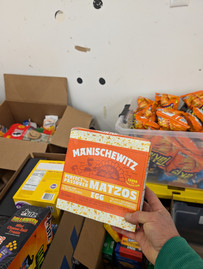Helene Recovery, Day 28: the flow of goods and goodwill
- Tal Galton
- Oct 24, 2024
- 4 min read
Updated: Oct 25, 2024

I spent a morning earlier this week volunteering at Fred’s. Fred’s the institution was a discount store that briefly operated as the anchor storefront of an aging stripmall called Burnsville Plaza. Fred’s the building is still there, proudly bearing the bankrupt company’s name in large, loud font. Fred’s is now the central distribution point of relief supplies for the town of Burnsville. It’s essentially a free grocery store, with a several years’ supply of toothpaste, and more manageable amounts of (or at least more consumable) consumer goods like canned food, ramen, MREs, and toilet paper.
My job was to unpack pallets of donated goods, which was a nice break from chainsawing, gravel moving, and demolition work. The stacks of boxes had been palletized and cellophane-wrapped at the high school before being delivered by the National Guard to Fred’s. Some pallets were full of canned beans or chef-boyardee in new boxes, and other pallets were random assortments of food – I could picture the person on the other end, digging deep into their pantry to donate decades-old jello boxes and bottles of unwanted salad dressing to their own community’s Helene-response canned food drive. The Fred’s scene was chock-full of deep ironies of late stage capitalism, George Saunders-style: a 15-year-old leaky jar of mint jelly; teetering towers of adult diapers; and piles of My Patriot Supply survival rations for your cellar, to be stored alongside your gun safe of AR-15s.
One well-labeled carton that I unboxed contained a set of individual, one-gallon ziplock care packages marked: “men’s,” “women’s,” “boy’s,” and “girl’s.” Each bag had a warm hat, socks, deodorant for the adults, and coloring books or matchbox cars for the kids. I pictured the homeschool family project that produced these lovingly sorted packages, and I thought about the compassion that energized the activity – that feeling I recall, even pre-social media, of being a thousand miles from the devastation of Katrina and wanting to do something, anything, to help. I appreciated the tender sentiments contained in each baggy, even as I unpacked them and re-sorted them into their proper areas of the supply store.
There must be several hundreds of local residents unhoused by the storm. At last count, Yancey County numbered 18,000 total residents, and I shudder to think what percent must now be at least temporarily without a safe and warm home. There is a constant stream of people coming into Fred’s for blankets and canned goods.
Next door to Fred’s is GO: Grocery Outlet. GO Grocery is a long-standing Burnsville establishment. It was there long before Fred’s, and has persisted well past Fred’s closing. Now, my heart goes out to GO. As a discount grocer fondly known for its eclectic selection of low-priced expired or near-expired snack food and cereal, it must be hard to compete with a store next door, full of free-for-the-taking expired and near-expired snack food.
I came home with a few items: cans of coconut milk, ramen, a solar-powered kettle, a box of protein bars for the cross country team, and two bags of Thai-inspired rice snacks called Dang’s. The sun kettle, though properly phallic, is a dud. I tested it out in the brightest sunshine we ever see in WNC; after several hours it warmed a pint of water to 130°. It must be meant for retirees in Arizona who don’t mind waiting through the midday sun for a cup of tea. I’m more of a drink-my-tea-in-the-cool-hours-before-dawn kind of guy. The sweet coconutty bag of Dang’s was pretty tasty (expiration: 4/2022). The savory sriracha flavored one (exp: 11/2020) was beyond the pale of rancid and stale. It’ll bypass the cross country kids and go straight to the chickens – one of my garden interns once told me that chickens only have 10 taste buds on their tongue. Jess said maybe our experience of Dang snacks is like seeing the light from a now-dead star, or in this case, a flamed-out snack brand. But I looked them up, and Dang seems to be going strong, and still features sriracha rice chips.
It’s heartening to see the muscle of the US military apparatus – service members, humvees, and transport trucks – unarmed and at work, schlepping pallets of water and diapers on roughed-up country roads. And yet, something chafes – a bristly thread under my collar. There is clearly a disaster-industrial complex at play here. Goodwill, philanthropy, and downright generosity notwithstanding, there is a lot of private and public money flowing into this disaster. It’s hard to shake the feeling that several sectors of the American economy are benefitting from this natural(?) disaster. It is essential for people whose lives were displaced or disrupted to have the blankets and food and water that they need. Fortunately as the flood waters drained from the area, Yancey County was inundated by a tidal wave of donated diapers, sleeping bags, and granola bars. And yet the irony is not lost on (some of) us that the national response to this climate catastrophe was to swarm the region with helicopters and humvees, delivering endless streams of goods and gas and generators.
For further reading, here are a couple of new worthwhile Helene write-ups:
Cynthia Barnett penned a wonderful treatment of Celo and our Helene response that was published in Sierra Magazine (accompanied by a few of my blog photos).
Brooke Jarvis wrote this essay for the NYTimes Magazine about the ‘gramification of climate disasters. Brooke cites an anonymous viral quote: “Climate change will manifest as a series of disasters viewed through phones, with footage that gets closer and closer to where you live until you’re the one filming it.” Ooof, that one hits home.

















Comments